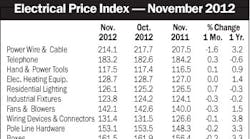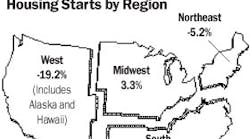Latest from Mag
People - Dec 21, 2012
Obituaries - Dec 21, 2012
November EPI Index Shows No Change
Housing Starts Dip 4% in November
Electrical Marketing - December 21, 2012
Around the Industry - Dec 21, 2012
Nationwide housing production fell 10.6 percent to a seasonally adjusted annual rate of 529,000 units in October as builders awaited word on whether an important home buyer incentive would be extended, according to the U.S. Commerce Department.
The Worker, Homeownership, and Business Assistance Act of 2009, signed into law by President Obama on Nov. 6, extends the deadline for the first-time home buyer tax credit and gives a larger group of home buyers the chance to take advantage of this government program. The new law extends the $8,000 first-time home buyer credit through April 30, 2010, giving buyers who have signed a sales contract by that deadline until June 30 to close their deal.
“As of October, the deadline for starting a home that could be completed in time for purchasers to take advantage of the $8,000 first-time home buyer tax credit had come and gone, and builders had no clear sign of whether Congress would extend the credit beyond the end of November,” said Joe Robson, chairman of the National Association of Home Builders (NAHB) and a home builder from Tulsa, Okla. “However, now that Congress has wisely moved to extend the tax credit into next year and expand its eligibility to more buyers, we hope and expect that this will have a substantial stimulative effect on home sales and help keep the housing market solidly on the road to recovery.”
“Builders were clearly in a holding pattern in October as the future of the home buyer tax credit hung in the balance,” said NAHB Chief Economist David Crowe. “This is not surprising, given the fact that the tax credit had been the primary driver of construction and sales in the summer and early fall. However, the fact that permits for single-family construction remained roughly unchanged in the month is an indication that builders are preparing for the possibility of more favorable housing market conditions in the future.”
Single-family housing starts declined 6.8 percent in October to a seasonally adjusted annual rate of 476,000 units, the slowest pace since May of this year. Meanwhile, multi-family housing starts fell by a dramatic 34.6 percent to a seasonally adjusted annual rate of just 53,000 units — the slowest pace on record.
Combined starts activity fell across the board in October, with the Northeast posting an 18.8 percent decline, the Midwest a 10.6 percent decline, the South a 9.6 percent decline and the West an 8.5 percent decline, respectively.
Permit issuance, which can be an indicator of future building activity, fell 4 percent overall in October to a seasonally adjusted annual rate of 552,000 units, due primarily to a double-digit drop-off on the multi-family side. While single-family permits held virtually flat at 451,000 units, multi-family permits were down nearly 18 percent to 101,000 units.

